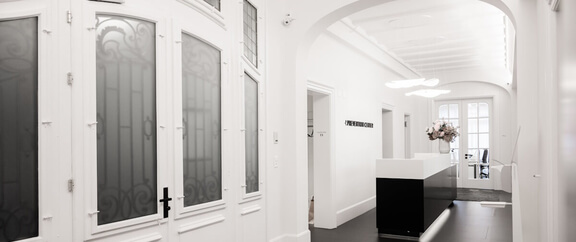Facts on Breast Enlargement surgery
| Medical term | Augmentation Mammoplasty |
|---|---|
| Treatment | outpatient |
| Duration | 1 hour |
| Anaesthesia | sedation |
| After care | Sports bra for 4 weeks no exercise for 3 months |
| Prices | CHF 6'900: Breast Augmentation mybreast CHF 9'900: Hybrid Breast Enlargement CHF 8'900: Breast Correction |
Breast augmentation or breast enlargement is an operation in which an implant is used to increase the size of the female breast. The following information may be of interest to any patient who is interested in a breast augmentation. For more detailed information, it is important to arrange a personal consultation.
Benefits of breast enlargement surgery
at prevention-center

- The price includes consultation and surgery by a qualified physician with 18 years of experience
- More than 4,000 performed breast surgeries
- Anesthesiologists with many years of experience and the highest level of safety enable you to go home after 1 to 2 hours. (Breast surgery should not be done without a trained anaesthetist - not just a specialised doctor or nurse for anaesthesia, ask for it)
- Using high-quality breast implants from Mentor (Johnson & Johnson) with a lifetime warranty
- Use of different implants possible upon request (and additional charge), e.g. Allergan, B-Lite, Motiva
- Application of the no-touch technique for sterile and germ-free insertion of implants
- Individual planning of the result according to the customer's wishes
- Experienced team, which ensures your wellbeing both before the operation and after the surgery
- Class 1 surgery of the highest clinic standard
- Minimally invasive technique with cutting lengths of 3 to 4 cm
- Unique waterproof wound dressing that allows you to shower on the first day after surgery
- Self-dissolving threads, no dressing changes necessary
- Less than 1 percent complication rate due to permanent quality assurance for more than 10 years
Indications
A breast augmentation operation can safely achieve augmentation of the breasts. The objective is to create an aesthetic and natural breast shape. A good nipple (mamilla) position is a prerequisite. If the nipple is too low, the patient generally requires an additional breast uplift (your doctor can explain this to you in more detail). This causes additional scarring. Different sizes of prostheses can be used for patients with breasts of varying sizes. However, it can be difficult to achieve absolute symmetry - something that is equally rarely achieved in nature, if at all. If the breast is only to be enlarged, a small incision is made along the underside of the breast, or along the areola.
Breast Implants
A filled silicone pouch is normally used to enlarge the breast. The pouch is filled with saline solution or silicone gel. Anatomical breast implants are a recent development in this form of implant. They have more filling at the bottom and therefore create a better imitation of a natural breast shape. This can be especially beneficial for very slender women. This innovation has been made possible by the development of high cohesive gel (more cross-linked than standard gel). It is more form-stable and yet almost as soft as the silicone gel used in implants for many years. It is almost impossible for the silicone to leak from these prostheses. The use of polyurethane-coated implants brings a high level of comfort, and the best possible safety standards.
Is it necessary to change the prostheses after a few years?
There are no guidelines regarding the changing of prostheses. Modern prostheses can be left for 10 - 15 years without any problems. Regular monitoring is sufficient, provided the patient does not have any discomfort.
Consultation
The patient has the opportunity to discuss the changes that they wish to carry out to improve the appearance of their breasts. Also discussed are the size and type of implant, the type of incision, the position of the implant, and whether an additional breast uplift is also required to provide optimum correction of the breast.
The doctor also asks questions about the patient's health, e.g. if she is taking any medication or if there is a history of breast cancer in her family etc.
The Breast enlargement
During a breast augmentation, an incision is made in the skin and the breast tissue is lifted to create a pocket into which the implant can be inserted. The breast implants can either be placed under the pectoral muscle or under the mammary gland located above the pectoral muscle. The decision as to the position of the implant depends upon the shape of the breast, the type of implant, and other criteria.
Anaesthetic
In most cases the operation is carried out under general anaesthetic.
Length of the operation
A breast augmentation operation generally takes 2 hours. The length of the operation depends on the technique being used, and the position of the implants.
Is treatment on an outpatient or inpatient basis?
A breast enlargement can be performed on an outpatient basis. The patient can usually return home after a few hours of rest.
About the augmentation procedure
The dressing should be changed after approximately one week. It must be worn for 6 weeks in order to ensure optimal scar formation. The patient should also wear a support bra constantly for several weeks until the swelling subsides and the breast heals from within. Light physical activity can be resumed after just a few days. Major physical activity such as sport should be avoided completely for 3 months. This helps with scar healing.
During the first months after surgery some women report a small, sudden stinging sensation in the nipples and on the side of the breast. This pain is usually caused by reinnervation, which means that the skin nerves are starting to grow again, and the feeling improves with time.
It is possible to have a shower from the second day after the operation while wearing the adhesive dressing.
The ability to breastfeed generally remains, but this cannot be guaranteed. The scars will appear red for a few weeks, but they become paler after a few months. Any foreign body sensation gradually disappears.
Risks & Side Effects
The following complications are rare, but they may occur: post-operative infection, secondary bleeding with haematoma (an effusion of blood), loss of sensation in the breast skin and nipple, implant slippage. Capsular contracture occurs when the natural scar around the implant (the connective tissue capsule) contracts and causes a firm, painful swelling. The risk of this complication is lowest when a polyurethane-coated implant is used (according to scientific studies).
A loss of sensation in the breast or nipple usually improves within a few weeks or months, but in rare cases it can be permanent.
Ripples and creases in the skin may form, depending on the thickness of the skin and the type and size of implant. They mainly become visible when the implant moves.
Please remember!
Nicotine consumption should ideally be stopped for 3 weeks before and after the operation (this helps the wound to heal).
Please avoid blood-thinning medication such as aspirin, ASS and Marcoumar, as well as non-steroidal anti-inflammatory drugs. Your doctor will advise you.
Please arrange to be collected and driven home after the operation. Please inform us immediately if you notice any fever, redness, sudden pain or other symptoms of infection or any other problems after treatment.
Findings on Breast Augmentation
Many wide-ranging studies have shown that breast cancer does not occur more frequently after a breast enlargement with silicone prostheses. It may even occur slightly less frequently. No link has been established between silicone prostheses and autoimmune diseases (such as rheumatism, lupus erythematosus or scleroderma).
Before & After Pictures
Take a look at the pictures on our breast augmentation before & after gallery.
Frequently Asked Questions about Breast Augmentation
What exactly is breast implant illness (BII)?
BII (breast implant illness), also known as ASIA (autoimmune syndrome induced by adjuvants), is a syndrome associated with silicone breast implants. It is the subject of considerable discussion, particularly on social media. In addition to numbness and a skin rash, symptoms can also include tachycardia, chronic fatigue, forgetfulness, joint pain, migraines, difficulty concentrating and muscle weakness. However, no study to date has demonstrated a direct link between breast implants and breast implant illness. In addition, the WHO has not recognised BII as an illness
Nevertheless, people with BII are recommended to have their implants removed as well as partial or complete removal of the capsule. The risks of this procedure include secondary haemorrhage and pneumothorax.
Contact

PREVENTION-CENTER AG UTOSCHLOSS
Utoquai 31
8008 Zürich
How to get there
PREVENTION-CENTER AG ZUG
Aabachstrasse 8
6300 Zug
How to get there
PREVENTION-CENTER AG BERN
Kornhausplatz 7
3011 Bern
How to get there
PREVENTION-CENTER AG ST. GALLEN
Kornhausstrasse 25
9000 St. Gallen
How to get there
VISITING HOURS
| MO - FR | 8 AM - 6 PM |
OVER THE PHONE
| MO - FR | 8 AM - 5 PM |

